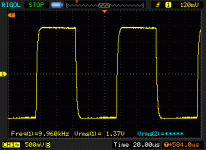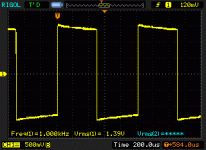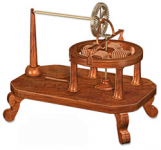The largest film cap available at 600-650V from DigiKey is this:
It's non-stock and you need to buy 50 of them for almost 12 grand...
We've used these ECI pp film caps for quite a while.
UP3 Series | Film Capacitor - Electronic Concepts Inc.
UL30 Series | Film Capacitors - Electronic Concepts Inc.
UP37 Series | Film Capacitors - Electronic Concepts Inc.
These are .bmp files, the standard Windows Paint files, but most image programs on most OSes should open them. When you clicked on them they were probably stored as a download on your computer.Generally:
Not sure of the application (the attached images would not open).
Alternate explanations of such measurements are always welcome, at least by me.Where such small voltages were measured in a basic grid coupling circuit, it might well have been caused by electrons landing on the grid, not necessarily capacitor leakage per sé. The latter is best measured in a passive circuit. In capacitor coupled circuits it is normal to measure a few mV on the grid, depending on the measuring topology and circuit values.
I too find challenging accepted theories satisfying. Not as a troll, but keeping open to possibly of error in accepted physics ie SR special relativity. There definitely is a sonic difference between caps of equal value, esr, xc etc. I use muse bipolar 10uf in parallel with film 1uf for line level outputs. Last layout recently added smt pads to test if any difference replacing green muse with 10uf ceramic cog. The Thd and so on had no change. But sonically the ceramic sounded anemic. Black and white difference no question about it.
I too find challenging accepted theories satisfying. Not as a troll, but keeping open to possibly of error in accepted physics ie SR special relativity.
Nothing wrong with that - I was paid a salary to research matters, and 'progress' sometimes took funny routes to say the least!
But I stop where there is certainty regarding certain aspects of science. (In this case electronics.) Put differently, I stop at re-inventing the wheel (not saying you disagree). One must move on. E.g. gravity or similar matters that are clearly impossible to violate/proven over and over. Scientists do not know everything, but they do know certain things.
Regarding the 'sound' of capacitors I will not now enter into discussion with you. Just to say (respectfully!) . . . . perhaps to use Douglas Self's words: " 'I have tied a knot in my speaker cable and it sounded different' does not constitute proof."
But the whole science of hearing (medico-acoustical stuff) is a study on its own.
Last edited:
I too find challenging accepted theories satisfying. Not as a troll, but keeping open to possibly of error in accepted physics ie SR special relativity. There definitely is a sonic difference between caps of equal value, esr, xc etc. I use muse bipolar 10uf in parallel with film 1uf for line level outputs. Last layout recently added smt pads to test if any difference replacing green muse with 10uf ceramic cog. The Thd and so on had no change. But sonically the ceramic sounded anemic. Black and white difference no question about it.
science and theory are fine, it is our interpretations of them that is the thing....
many times our interpretations of science and theories are open to interpretations, that is where the fun is...
i have stromberg carlson tube amps that used only ceramics in the signal path and yet sounded creamy and fabulous, why do you think is that?
I bet you blamed the microphonic chassis on the tubes!science and theory are fine, it is our interpretations of them that is the thing....
many times our interpretations of science and theories are open to interpretations, that is where the fun is...
i have stromberg carlson tube amps that used only ceramics in the signal path and yet sounded creamy and fabulous, why do you think is that?
I bet you blamed the microphonic chassis on the tubes!
It gives a creamy ambience, sort of a harmonic tracking generator.
Attachments
Carefully continuing with this ...
Jfetter: Not disputing your honest experience. I was not there to contradict/offer an opinion.
But I did mention psycho-acoustics. Many experiments have shown that the same hearing can come to different conclusions, depending. One of many: I believe members are aware of the not unbiased different opinions ('experiences?') regarding tone controls? This to the extent that commercial products often include disabling/bypassing switches
as I once did in an otherwise kosher amplifier. Demoed in a large room, some tested this 'facility', pronouncing with undoubtful conviction that to them the difference though slight, was definitely audible. Reality: That switch was there but not wired in!
Likewise one can run a pink noise test with a 3 Khz signal barely but definitely audible in the spectrum. Only an oscilloscope attached will show that no such signal is present.
Etc. - all of which indicates that perfectly normal hearing is capable of misjudging depending on certain conditions. The ear is not a calibrated measuring device. Quite a while ago, but I recall interesting research results by a.o. Dr. Diana Deutsch in the difficult field of subjectivity in human hearing.
and caveat: This does not (necessarily) denote a shortcoming in anybody's hearing. It depends on the circumstances.
But possibly O.T. Back to subject.
Jfetter: Not disputing your honest experience. I was not there to contradict/offer an opinion.
But I did mention psycho-acoustics. Many experiments have shown that the same hearing can come to different conclusions, depending. One of many: I believe members are aware of the not unbiased different opinions ('experiences?') regarding tone controls? This to the extent that commercial products often include disabling/bypassing switches
as I once did in an otherwise kosher amplifier. Demoed in a large room, some tested this 'facility', pronouncing with undoubtful conviction that to them the difference though slight, was definitely audible. Reality: That switch was there but not wired in!
Likewise one can run a pink noise test with a 3 Khz signal barely but definitely audible in the spectrum. Only an oscilloscope attached will show that no such signal is present.
Etc. - all of which indicates that perfectly normal hearing is capable of misjudging depending on certain conditions. The ear is not a calibrated measuring device. Quite a while ago, but I recall interesting research results by a.o. Dr. Diana Deutsch in the difficult field of subjectivity in human hearing.
and caveat: This does not (necessarily) denote a shortcoming in anybody's hearing. It depends on the circumstances.
But possibly O.T. Back to subject.
I downloaded a white paper , can't put it here is copyrighted. It's about psy acoustics and the effect of ethanol consumption. Interesting how different music, volume and affect the *perceived* reality. I'm curious too if prescription drugs or full spectrum CBD have any effect.
Yes I understand what you are saying.
But I'm sticking with my empirical test results.
yes, sure you can....
controversies arise when one pushes those as the truth...
In addition to audio one of my other hobbies is early history of electric devices. In one example, 'truth' said it was impossible to create any electric device that could mechanically do work. So Mr Davenport (a blacksmith) could not obtain a patent for his motor. Eventually real science did prevail and he did obtain one of the first US patents. The examiners initally said it was a magic trick when shown a working example.
It dragged on for years until Mr Davenport was penniless.
The 'truth' it seems is not an absolute.
It dragged on for years until Mr Davenport was penniless.
The 'truth' it seems is not an absolute.
Attachments
Last edited:
to me anything polypropylene is good enough....an offshoot of the 1980 article on picking capacitors, Audio Magazine 1980 that started a whole who capacitor appreciation culture...
i have a stromberg carlson tube amp that used nothing but ceramic coupling caps that sounded so good..
truth is truth, whether we believe it or not...
i have a stromberg carlson tube amp that used nothing but ceramic coupling caps that sounded so good..
truth is truth, whether we believe it or not...
What do you think of them?We've used these ECI pp film caps for quite a while.
UP3 Series | Film Capacitor - Electronic Concepts Inc.
UL30 Series | Film Capacitors - Electronic Concepts Inc.
UP37 Series | Film Capacitors - Electronic Concepts Inc.
Very good, ask them for a couple of samples and see.What do you think of them?
They have many more types as well.
https://www.ecicaps.com/film-capacitors/
i have a stromberg carlson tube amp that used nothing but ceramic coupling caps that sounded so good..
If their time constant is high enough, then even ceramic capacitors are appropriate for coupling. And with the voltages present in tube amps, any other kind of cap can be pretty expensive.
Just apply KVL to the input circuitry at the lowest frequency signal to be coupled. That will tell you whether the cap will affect the circuit or not. The actual transfer function of a capacitor's value vs voltage can be quite nonlinear, but if the impedance of the capacitor is much smaller than the input impedance then this will have negligible effect on the circuit operation. Since a tube grid typically has an input impedance of many megohms, the gross nonlinearity of a ceramic capacitor is negligible if a large enough value is used.
- Home
- Member Areas
- The Lounge
- coupling caps 3 approaches



